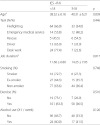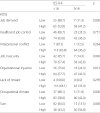1. Chen YS, Chen MC, Chou FH, Sun FC, Chen PC, Tsai KY, et al. The relationship between quality of life and posttraumatic stress disorder or major depression for firefighters in Kaohsiung. Taiwan Qual Life Res. 2007; 16(8):1289–97. DOI:
10.1007/s11136-007-9248-7.
2. Corneil W, Beaton R, Murphy S, Johnson C, Pike K. Exposure to traumatic incidents and prevalence of posttraumatic stress symptomatology in urban firefighters in two countries. J Occup Health Psychol. 1999; 4(2):131–41. DOI:
10.1037/1076-8998.4.2.131. PMID:
10212865.
3. Heinrichs M, Wagner D, Schoch W, Soravia LM, Hellhammer DH, Ehlert U. Predicting posttraumatic stress symptoms from pretraumatic risk factors: a 2-year prospective follow-up study in firefighters. Am J Psychiatry. 2005; 162(12):2276–86. DOI:
10.1176/appi.ajp.162.12.2276. PMID:
16330591.
4. Kwon SC, Song JC, Lee SJ, Kim IA, Koh JW, Ryou HC, et al. Posttraumatic stress symptoms and related factors in firefighters of a firestation. Korean J Occup Environ Med. 2008; 20(3):193–204.
5. Lima Ede P, Assuncao AA. Prevalence and factors associated with Posttraumatic Stress Disorder (PTSD) in emergency workers: a systematic literature review. Rev Bras Epidemiol. 2011; 14(2):217–30. DOI:
10.1590/S1415-790X2011000200004. PMID:
21655689.
6. McFarlane AC. The longitudinal course of posttraumatic morbidity. The range of outcomes and their predictors. J Nerv Ment Dis. 1988; 176(1):30–9. DOI:
10.1097/00005053-198801000-00004. PMID:
3335835.
7. King LA, King DW, Fairbank JA, Keane TM, Adams GA. Resilience-recovery factors in post-traumatic stress disorder among female and male Vietnam veterans: hardiness, postwar social support, and additional stressful life events. J Pers Soc Psychol. 1998; 74(2):420–34. DOI:
10.1037/0022-3514.74.2.420. PMID:
9491585.
8. Bramsen I, Dirkzwager AJ, van der Ploeg HM. Predeployment personality traits and exposure to trauma as predictors of posttraumatic stress symptoms: a prospective study of former peacekeepers. Am J Psychiatry. 2000; 157(7):1115–9. DOI:
10.1176/appi.ajp.157.7.1115. PMID:
10873920.
9. Ehlers A, Mayou RA, Bryant B. Psychological predictors of chronic posttraumatic stress disorder after motor vehicle accidents. J Abnorm Psychol. 1998; 107(3):508–19. DOI:
10.1037/0021-843X.107.3.508. PMID:
9715585.
11. Regehr C, Hill J, Knott T, Sault B. Social support, self-efficacy and trauma in new recruits and experienced firefighters. Stress Health. 2003; 19(4):189–93. DOI:
10.1002/smi.974.
12. Chang SA, Koh SB, Kang DM, Kim SA, Kang MK, Lee CG, et al. Developing an occupational stress scale for Korean employees (in Korean). Korean J Occup Environ Med. 2005; 17(4):297–317.
13. Kwon SY, Lee EJ, Kim HC. The relationship between job stresses and clinical scales of Minnesota Multiphasic Personality Inventory(MMPI) in male firefighters. J Korean Soc Biol Ther Psychiatr. 2009; 15(1):96–104.
14. Lee DH, Jeon HJ, Shin DH, Chung IS, Lee MY. Association between job stress and the Minnesota multiphasic personality inventory in firefighters. Korean J Occup Environ Med. 2009; 21(4):324–36.
15. Park SG, Min KB, Chang SJ, Kim HC, Min JY. Job stress and depressive symptoms among Korean employees: the effects of culture on work. Int Arch Occup Environ Health. 2009; 82(3):397–405. DOI:
10.1007/s00420-008-0347-8. PMID:
18622624.
16. Kim ZS. Minnesota Multiphasic Personality Inventory Seoul: Seoul National University Press. 1994.
17. Eun HJ, Kwon TW, Lee SM, Kim TH, Choi MR, Cho SJ. A study on reliability and validity of the Korean version of impact of event scale-revised. J Korean Neuropsychiatr Assoc. 2005; 44(3):303–10.
18. Breslau N, Davis GC, Andreski P, Peterson E. Traumatic events and posttraumatic stress diosrder in an urban population of young adults. Arch Gen Psychiatry. 1991; 48:216–22. DOI:
10.1001/archpsyc.1991.01810270028003. PMID:
1996917.
19. Choi ES. A model for post-traumatic stress and burnout in firefighters. Korean J Emerg Med Ser. 2001; 5:147–64.
20. Yu JH, Park KH. Psycho-social variables related to PTSD symptoms in fire-fighters: focusing on depression, anxiety, coping style, and social support. Korean J Clin Psychol. 2009; 28(3):833–52. DOI:
10.15842/kjcp.2009.28.3.010.
21. Lim HK, Woo JM, Kim TS, Kim TH, Choi KS, Chung SK, et al. Reliability and validity of the Korean version of the impact of event scale-revised. Compr Psychiatry. 2009; 50(4):385–90. DOI:
10.1016/j.comppsych.2008.09.011. PMID:
19486738.
22. Breslau N, Davis GC, Andreski P. Risk factors for PTSD-related traumatic events: a prospective analysis. Am J Psychiatry. 1995; 152(4):529–35. DOI:
10.1176/ajp.152.4.529. PMID:
7694900.
23. Breslau N, Davis GC. Posttraumatic stress disorder in an urban population of young adults: risk factors for chronicity. Am J Psychiatry. 1992; 149(5):671–5. DOI:
10.1176/ajp.149.5.671. PMID:
1575259.
24. Hidalgo RB, Davidson JR. Posttraumatic stress disorder: epidemiology and health-related considerations. J Clin Psychiatry. 2000; 61(Suppl 7):5–13. PMID:
10795604.
25. Breslau N. Epidemiologic studies of trauma, posttraumatic stress disorder, and other psychiatric disorders. Can J Psychiatry. 2002; 47(10):923–9. PMID:
12553127.
26. Buckley TC, Mozley SL, Bedard MA, Dewulf AC, Greif J. Preventive health behaviors, health-risk behaviors, physical morbidity, and health-related role functioning impairment in veterans with post-traumatic stress disorder. Mil Med. 2004; 169(7):536–40. PMID:
15291186.
27. Cheryl R, John H, Theresa K, Bill S. Social support, self-efficacy and trauma in new recruits and experienced firefighters. Stress Health. 2003; 19(4):189. DOI:
10.1002/smi.974.
28. Bryant RA, Guthrie RM. Maladaptive appraisals as a risk factor for posttraumatic stress: a study of trainee firefighters. Psychol Sci. 2005; 16(10):749–52. DOI:
10.1111/j.1467-9280.2005.01608.x. PMID:
16181434.
29. Ha J, Kim DI, Seo BS, Kim WS, Ryu S, Kim SG. Job stress and psychosocial stress among firefighters. Korean J Occup Environ Med. 2008; 20(2):104–11.
30. Choi CK, Lee CG, Song HS, Yoo SY, Kim SH. Occupational stress and MMPI-2 profile of workers in some plants undergoing labor dispute. Korean J Occup Environ Med. 2012; 24(4):384–96.
31. Schnurr PP, Friedman MJ, Rosenberg SD. Premilitary MMPI scores as predictors of combat-related PTSD symptoms. Am J Psychiatry. 1993; 150(3):479–83. DOI:
10.1176/ajp.150.3.479. PMID:
8434666.
32. Farnsworth JK, Sewell KW. Fear of emotion as a moderator between PTSD and firefighter social interactions. J Trauma Stress. 2011; 24(4):444–50. DOI:
10.1002/jts.20657. PMID:
21780188.
33. Daie-Gabai A, Aderka IM, Allon-Schindel I, Foa EB, Gilboa-Schechtman E. Posttraumatic Cognitions Inventory (PTCI): psychometric properties and gender differences in an Israeli sample. J Anxiety Disord. 2011; 25(2):266–71. DOI:
10.1016/j.janxdis.2010.09.012. PMID:
20971609.





